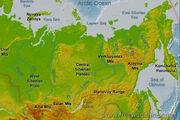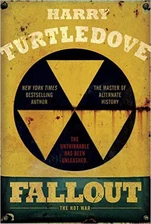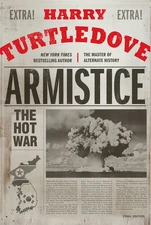
Kolyma in the far east, south of the East Siberian Sea and north of the Sea of Okhotsk.[1]
Kolyma (Russian: Колыма́, IPA: [kəlɨˈma]) is a region located in the Russian Far East. It is bounded by the East Siberian Sea and the Arctic Ocean in the north and the Sea of Okhotsk to the south. The region gets its name from the Kolyma River and mountain range, parts of which were not discovered until 1926. Today the region consists roughly of the Chukotka Autonomous Okrug and the Magadan Oblast.
The area, part of which is within the Arctic Circle, has a subarctic climate with very cold winters lasting up to six months of the year. Permafrost and tundra cover a large part of the region. Average winter temperatures range from -19 °C to -38 °C (even lower in the interior), and average summer temperatures, from +3 °C to +16 °C.
Under Joseph Stalin's rule of the Soviet Union, Kolyma became the most notorious region for the Gulag labor camps. Tens of thousands or more people may have died en route to the area or in the Kolyma's series of gold mining, road building, lumbering, and construction camps between 1932 and 1954. It was Kolyma's reputation that caused Aleksandr Solzhenitsyn, author of The Gulag Archipelago, to characterize it as the "pole of cold and cruelty" in the Gulag system.
Kolyma in "Getting Real"[]
The People's Republic of China took control of Kolyma in the twenty-first century. They found the gold mines there as useful for disposing of unreliables as the Soviet Union had in the twentieth century. Prior to the outset of the Sino-American War of 2117, Minister Hu Zhiaoxing had worried about the possibility of being sent to Kolyma if the war had gone badly for China. However, as China won the war, Kolyma was not his worry.[2]
Kolyma in The Hot War[]
When the Soviet Air Force Base in Provideniya was put on high alert after an exchange of atomic bombings with the United States, Colonel Doyarenko warned his flight crews to not do any drinking or they would be sent to Kolyma. A few days later, one flight crew did disappear. Captain Boris Gribkov didn't know they had disobeyed orders but didn't want to take the chance of ending up in Kolyma and so stayed sober.[3]
Kolyma in "Les Mortes d'Arthur"[]
Even after the dissolution of the Soviet Union, Kolyma remained a political prison camp in Czarist Siberia at the turn of the 23rd century. Media in both Siberia and the communist rump state of Moscow vainly attempted to censor this inconvenient fact from the outside world.
Kolyma in The War That Came Early[]
After World War II ended in 1944, Sgt. Ivan Kuchkov's regiment was pulled from Ukraine to fight the Japanese in a new conflict. After exiting the train in Irkutsk, Kuchkov and his company were arrested by the NKVD and told they were being shipped to Kolyma as punishment for treason.[4]
References[]
- ↑ Source: http://www.freeworldmaps.net/russia/map.html
- ↑ Asimov's Science Fiction, vol. 33, No. 3, Whole No. 398, March, 2009, pg. 106
- ↑ Bombs Away, pgs. 96-97, HC.
- ↑ Last Orders, pgs. 388-390, HC.
| |||||||||||
| |||||||||||||||||||||
| ||||||||||||||
| ||||||||||||||||||||||








